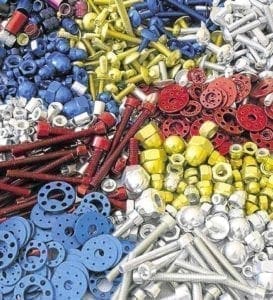How are bike nuts and bolts made?
Forging is the best method as it provides superior grain flow and directional strength when compared to casting, although it’s more expensive. The weakest area of fasteners is on their threads’ minor diameters (the ‘valleys’ of the threads, as opposed to their major diameters, which are the ‘peaks’ part of the thread). Thread dimensions of a cut and rolled thread are the same, so are identically strong.
Enjoy everything More Bikes by reading the monthly newspaper, Read FREE Online.
However, rolled threads have advantages over cut threads. When making cut threads, steel is cut away from a round (steel) bar to form the threads, which disturbs the grain. Roll threading is where steel is extruded, not removed, from the bar to form the thread, so doesn’t disturb the grain. Also, as a rolled threaded fastener has a smaller body diameter, it is lighter. This weight loss cuts the cost of the material (steel) and all the other processes associated with it, e.g. galvanizing, heat-treatment, plating etc. It also takes less time to make rolled threads, and if cold worked, makes these threads more resilient to damage through handling. Smoothness is also improved because of the ‘burnishing’ effect of the rolling production process.
Rolling also reduces the likelihood of galling. This is surface damage (normally roughening and the creation of ‘lumps’ that stick out above the original surface). It’s caused by material transfer from one metallic surface to another via movement, common on stainless steel, aluminium alloys and titanium.
What fasteners are on your bike?
Bike manufacturers commonly use high tensile, or high-strength, steel fasteners as they are cheap, can be used pretty much anywhere on the bike and also saves on assembly time at the factory.
They normally have a low-alloy content, with small quantities of other materials (e.g. 1.5-2% manganese) present that provides additional strength in the cheapest way possible. Sometimes poorer quality substrate material can be used, which can be painted or thinly plated instead.
Why is stainless steel used a lot?
This is a steel alloy with a minimum of 11% chromium content. It doesn’t stain, corrode, or rust as easily as ordinary steel (it stains less, but it isn’t completely stain-proof).
There are over 150 stainless steel grades with varying surface finishes available (brushed, satin etc) and it can be milled into pretty much anything, like bars, wire, tubes, coils and plates. To resist oxidation in ambient air temperatures further, more chromium can be added–up to26% can be added for use in severe environments. Chromium is used because it forms a layer of chromium oxide when exposed to oxygen. This layer is very thin (you can’t see it) and protects the steel underneath from water and air (and the resulting bad effects). If scratched, this layer has the capacity to quickly reform, or ‘heal’ itself. Called passivation, this process is also seen in aluminium and titanium.
Stainless steels can also be defined by their crystalline structure. Austenitic (non-magnetic) 300 series stainless steels are the most widely used. This type is a chromium-nickel alloy composite, containingminimum 16% chromium and maximum 0.15% carbon, plus enough nickel/manganese to keep its austenitic structure at all temperatures.
The two most common grades used for motorcycle fasteners are 304 (A2) and 316 (A4). A2 is the most prolific, and is known as 18/8 (18% chromium, 8% nickel content). A4 is made up of 18/10/3 (18% chromium, 10% nickel and 3% molybdenum), and can be known as ‘marine grade’ due to its added corrosion resistant qualities, especially against salt water or acids. Stainless steel is also cheaper than either aluminium or titanium but is heavier (titanium is typically 45% lighter).
How do I tighten bolts correctly?
Tightening is not an accurate or exact science. A screw’s thread may appear to be a simple piece of engineering but friction between that and the material it is being screwed into is important. Dry friction resists relative lateral motion of two solid surfaces in contact with each other. A subdivision of this is kinetic (sliding) friction, which is between two moving surfaces, and it is this sliding friction that a screw thread is subject to. Sliding friction is affected by differentmaterials (like aluminium, titanium or steel); hardness, lubrication etc, plus on small objects (like screws), surface roughness and contact area also have an effect.
As a result, getting the torque values right is always important, but vital when using titanium fitments, so a correct range torque wrench should be used to prevent under- or over-torque. Under-torque (not tight enough) on nuts and bolts and on the pieces they join together cause uneven loads to be transmitted, which can lead to extra wear or even premature failure (due to fatigue).
Over-torque can be just as detrimental because the nut or bolt could fail from overstressing the thread area.
What other materials are used?
Aluminium. It has excellent anti-corrosion qualities, is a durable, lightweight, non-magnetic and ductile metal, and is easily machined. It has approximately a third of the density and stiffness of steel.
Aluminium can be ‘alloyed’ with elements like copper and manganese to improve strength, but very strong aluminium alloys lose some of their corrosion fighting properties (due to galvanic reactions with alloyed copper.)
Heat treatment and manufacturing alsohave an impact on the strength and durability of aluminium alloys. Fatigue strength is also an issue. Alumimium alloys don’t have an easily defined fatigue limit (unlike steel) so fatigue failurewill occur at some point, which is why steel or titanium is used in high-stress areas on a bike (e.g. brake discs/mounts) instead.
Titanium is the other material commonly used for motorcycle fasteners, although it is the most expensive – titanium fastener manufacturers typically make their products from aerospace grade, high quality titanium. This is the most expensiveof the metals used onamotorcycle and as such, is normally the preserve of race teams. Using titanium fasteners on road bikes will not only reduce weight but a lot of items are ‘race’ finished (e.g. drilledholes in front caliper pins for lockwire use) so look good.
Titanium has the highest strength-to-weight ratio of any metal. It can be alloyed with aluminium, vanadium, molybdenum etc to produce strong, light alloys. Unalloyed, titanium is as strong as some steels, yet typically 45% lighter. It’s also very corrosion-resistant, is lowdensity, fairlyductile and canwithstand exposure to acids. Titanium is 60% more dense than aluminium, but more than twice as strong as the 6061-T6 grade aluminium alloy.
What is tensile strength?
The ultimate tensile strength (UTS) is the maximum resistance to fracture. Commercial (just over 99% pure) grades of titanium have ultimate tensile strength of approximately 63,000psi, (pounds per square inch). This is the same as low-grade steel alloys, but has the advantage of being much lighter.
When alloyed, titanium’s tensile strength can reach over 200,000psi (e.g. Beta C). Most good quality titanium motorcycle fastener manufacturers use titanium alloys with a UTS of between 120,000-160,000psi, depending on application. At this level, titanium can safely replace most stainless steel (and OE) fasteners, but as with anything, check first with the supplier of a particular fastener’s suitability with where you want to use it.
Advert
Enjoy everything More Bikes by reading the MoreBikes monthly newspaper. Click here to subscribe, or Read FREE Online.




